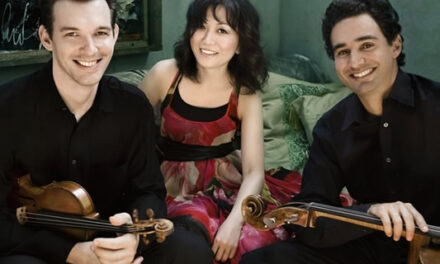Weekly concerts in the fine auditorium of Carol Woods Retirement Community often feature eclectic ensembles and programs to match. Guests for this concert are members of the Triangle Chamber Music Collective, a flexible group of professional musicians in the area who play lesser-known chamber works. Among its founding members are clarinetist Marianne Breneman and violinist Carol Chung, here joined by pianist Mimi Solomon, an active chamber musician and soloist.
The concert opened with a rare example of chamber music from the pen of Gian Carlo Menotti (1911-2007), the Italian-born American composer best known for operas, songs, and Broadway shows. He eschewed atonal music in favor of lyrical, tonal music, reminiscent of Puccini, to which he adapted popular elements drawn from Broadway musicals. He founded the Festival of Two Worlds at Spoleto, Italy, in 1958, to which he appended the Spoleto Festival USA in Charleston, SC, in 1977.
Menotti’s Trio for Violin, Clarinet, and Piano consists of three movements: Capriccio, Romanza, and Envoi. It was commissioned for the Michigan State University-based Verdeher Trio in 1989. Menotti had the two outer movements ready in 1995. He was notorious for running late and, according to Breneman, was still scribbling on the score up to noon on the day of September 1996 debut concert honoring his 85th birthday.
The work opened with Breneman spinning a fruity, march-like rhythm taken up in turn by Chung and Solomon. Menotti gives each player ample scope to weave solos or pair with melodic lines that were by turns whimsical and lyrical. Breneman’s breath-control and phrasing were remarkable over the course of the ravishing slow movement. Its wistful mood was brought out by the warm tones of Chung and Solomon. Fast runs and wide dynamics brought out the delights of the last movement dominated by an insouciant melody. Chung’s intonation was superb as was Solomon’s perfectly judged balance with the piano lid fully raised.
Russian composer Aram Khatchaturian (1903-45) is best known for showy, highly orchestrated works. He drew inspiration from the folksongs of Russian Armenia and nearby southern regions. Khatchaturian was still a student of Miaskovsky at Moscow Conservatory in 1932 when he composed his Trio in G minor for Violin, Clarinet, and Piano (1932). Unlike the clarinet trios of Mozart, Beethoven, and Brahms, which pair a viola or cello with the clarinet, Khatchaturian uses a violin as a more equal partner sharing melodic duties throughout. It is in three movements: Andante con dolore, Molto espressione, Allegro, and Moderato, a set of variations on a Uzbekistani folk song.
Breneman and Chung brought off the improvisational quality of the duet between clarinet and violin hovering above the layer of conflicting rhythms being spun by Solomon’s keyboard in the first movement. All three maximized the rich instrumental color and folk dance rhythms of the second movement. In the third movement, all the stops were pulled out to bring out the strongest possible contrast between the three instruments. Breneman exploited the clarinet’s full range from its rich, low chalumeau reedy sound to its precisely placed highest shrieks.
Hungarian composer Béla Bartók (1881-1945) was one of the greatest composers of the twentieth century. He drew heavily on aspects of vast collections of folk music he had made throughout the region. Folk music rhythms and melodic characteristics were creatively adapted into complex and subtle forms. Chamber music, such as his six string quartets, is central to his repertoire along with orchestral works, songs, and numerous keyboard pieces.
Bartók’s Contrasts for Violin, Clarinet, and Piano (1938 and 1940) was commissioned for violinist Joseph Szigeti and clarinetist Benny Goodman and premiered with the composer at the keyboard. It is in three movements: Verbunkos, Phenö, and Sebes. The first movement (a recruiting dance) and last movement (Fast) were completed in Budapest in September 1938 as Hitler was about to move on Czechoslovakia. Bartók inserted the central movement (Rest) in 1940 to complete this magnificent trio.*
Bartók’s title clearly indicates his intent-to throw the differences between instruments into high relief. Chung, Breneman, and Solomon delivered this in spades! Rhythms were infectious and what a wide palette of soaring highs jostling each other! It abounded scintillating trills, insistent ostinatos, vivid glissandi, and eerie chromatic progressions abounded. They evoked the composer’s characteristic “night music” in the spare sounds of the second movement. Chung’s self-confessed first foray into scordatura – deliberate mistuning of a second violin she used to open the third movement came off perfectly.** The white hot performance was rewarded with a sustained standing ovation.
*The complete performance of the three-movement version took place in the Columbia recording studios in New York, 1940. The Szigeti-Goodman-Bartók has never been out of print.
**Bartók requires a second violin tuned with the E string lowered a semitone and the G string raised to G-sharp. This violin is used for thirty bars before the player switches to a normally tuned instrument.












